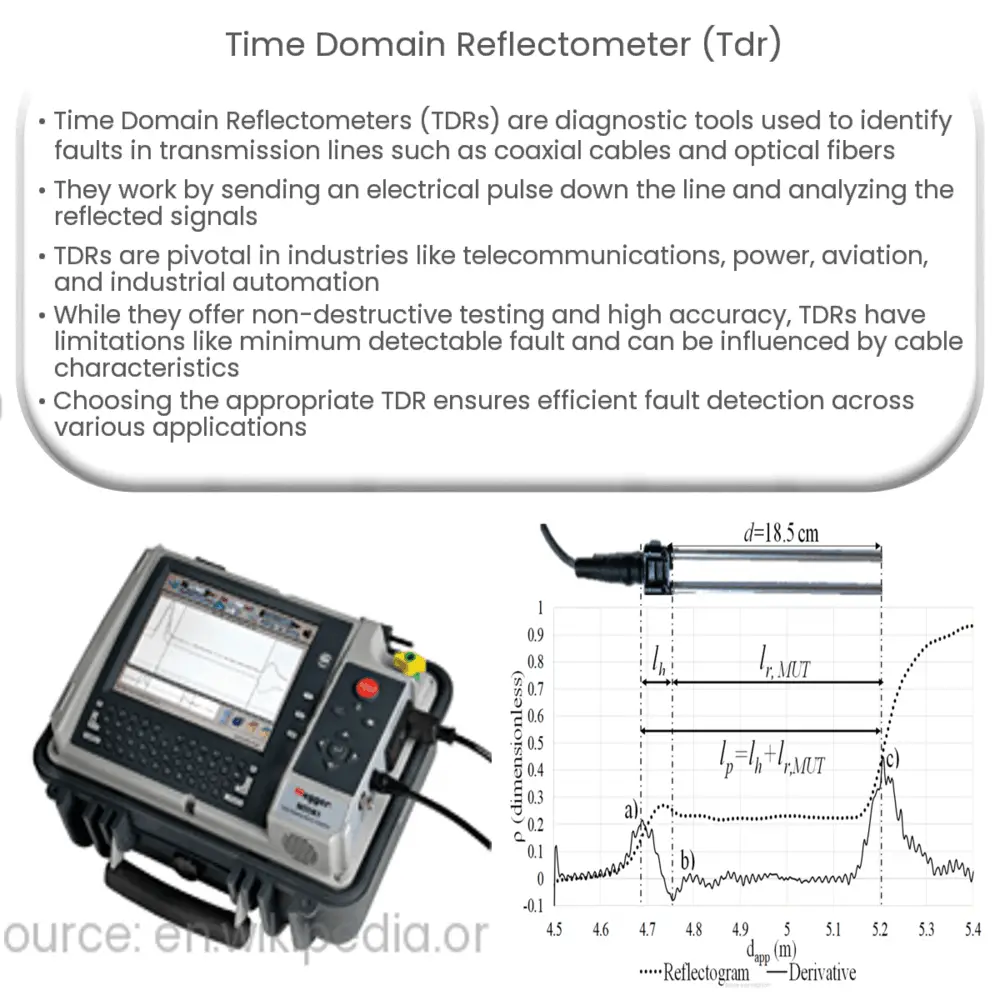A Time Domain Reflectometer (TDR) is a diagnostic tool used to locate faults in transmission lines, such as coaxial cables, twisted pairs, and optical fibers.

Time Domain Reflectometer (TDR): An Introduction
Overview
A Time Domain Reflectometer (TDR) is a versatile and powerful diagnostic tool used to locate and identify faults in various types of transmission lines, such as coaxial cables, twisted pairs, and optical fibers. It works by sending a high-speed electrical pulse down the line and then measuring the time it takes for the reflected signals to return. By analyzing the amplitude and time delay of these reflections, technicians can determine the location and nature of faults within the transmission line, making it an indispensable tool in the field of telecommunications and network troubleshooting.
Principle of Operation
A TDR operates on the principle of time-domain reflectometry, which is based on the observation that any change in impedance along a transmission line results in a reflection of the transmitted signal. When a TDR sends a fast-rising pulse down the line, the pulse encounters various impedance discontinuities, such as connectors, splices, or faults, causing a portion of the signal to reflect back toward the source. The time between the transmission of the pulse and the arrival of the reflection, along with the amplitude of the reflected signal, provide valuable information about the location and nature of the discontinuity.
Applications
Time Domain Reflectometers have a wide range of applications across various industries. Some of the most common uses include:
- Telecommunications: TDRs are extensively used for troubleshooting and maintaining copper and fiber optic communication lines. They help in identifying breaks, shorts, and impedance mismatches in the cables, ensuring smooth functioning of the communication network.
- Power Industry: TDRs can detect faults in power cables and distribution lines, such as insulation degradation or physical damage, reducing the risk of outages and increasing system reliability.
- Aviation and Aerospace: In aerospace applications, TDRs can detect and locate faults in various types of cables and connectors, ensuring the reliability and safety of critical systems.
- Industrial Automation: TDRs can be used for troubleshooting and maintaining wiring in automated manufacturing processes, minimizing downtime and increasing efficiency.
Advantages
Some of the key advantages of using a Time Domain Reflectometer include:
- Non-destructive Testing: TDRs enable technicians to locate and identify faults without physically accessing or damaging the cable.
- Accuracy: With advanced signal processing techniques, TDRs can accurately locate faults and estimate their severity, aiding in efficient fault resolution.
- Speed: TDRs can quickly identify and locate faults, reducing downtime and minimizing the impact on service availability.
Limitations
While Time Domain Reflectometers offer numerous advantages, they also have certain limitations that users should be aware of:
- Minimum Detectable Fault: TDRs have a limited resolution, which means that closely spaced faults or those with small impedance changes may not be accurately detected.
- Complex Waveforms: In some cases, multiple reflections can overlap and create complex waveforms, making it challenging to interpret the results and identify faults.
- Effect of Cable Characteristics: Variations in cable construction, such as changes in dielectric constant or conductor size, can affect the TDR’s ability to locate faults accurately.
Choosing the Right TDR
When selecting a Time Domain Reflectometer for a specific application, consider the following factors:
- Resolution: Choose a TDR with a resolution that is suitable for the specific application and the types of faults you expect to encounter.
- Dynamic Range: A higher dynamic range allows the TDR to detect smaller reflections, which can be essential when working with cables that have low levels of signal loss.
- Measurement Speed: Faster measurement speeds enable quicker fault detection and diagnosis, minimizing downtime.
- Portability: For field applications, consider a compact and portable TDR that can be easily transported and operated on-site.
- Additional Features: Some TDRs offer advanced features, such as built-in memory for storing test results, integrated GPS for location tracking, and automated test sequences. These features can increase efficiency and ease of use.
Conclusion
Time Domain Reflectometers are powerful diagnostic tools that play a crucial role in maintaining the integrity of various transmission lines across multiple industries. By understanding the principle of operation, applications, advantages, and limitations of TDRs, technicians can leverage this technology to accurately and efficiently identify and resolve faults in their respective systems. Choosing the right TDR for a specific application ensures optimal performance and helps maintain the reliability of communication networks, power distribution systems, and other critical infrastructure.

